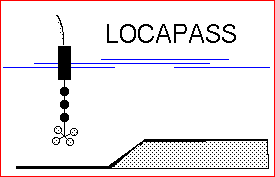|
You are not Logged in! Log in to check your messages. |

|
|
Check todays hot topics |
Web2Project Sign in
Project LOCAPASS

Passive source localization with a random network of acoustic buoys in shallow water (LOCAPASS)
LOCAPASS project main objective is to develop an acoustic passive localization integrated system using a single or a reduced number of acoustic sensors. The principle is based on the usage of the environmental information modelled by a numerical propagation model in order to discriminate the perturbation induced by the active sound source. This project is financed under the a FUP - Ministry of Defense contract, program "The ocean and its margins".
Abstract:
During the project it is foreseen the development of a buoy to receive both acoustic and oceanographic information, with local storage and processing as well as the capacity for on line monitoring and easy integration into a network. The developed buoy was tested at sea, in the region to the north of Elba I., in Italy, during the MREA'03 sea trial aboard the R/V ALLIANCE of the Saclant Undersea Research Centre between 18 and 26 June 2003. The achievements made during the project were of two types: scientific and technological. The scientific achievement encompasses the demonstration of the possibility of localizing submerged targets in depth and range using a sparse vertical array of sensors in a poorly known environment (see publicationsfor more details). The technological achievement relates to the planning, assembling and testing at sea in real conditions of a versatile system for acoustic and oceanographic data recording, integrated with real time applications for source localization, tomography, rapid environmental assessment (REA) and underwater communications - the AOB, version 0. This systems constitutes a real world class advancement in acoustic marine technology (see achievements for additional informations concerning the AOB.V0).
Objectives:
 to develop an integrated system
for passively localizing a sound source using a single, or a reduced
number, of acoustic sensors. The principle is based on the usage of the environmental
information modelled with a numerical acoustic propagation model to discriminate
the perturbation sound source from the ambient background. Results obtained
previously have shown that: i) if the emitted signal has a relatively large
time*bandwidth product and ii) if the environmental background is relatively
well known and stable, it is indeed possible to localize an acoustic sound
source in depth and range with a single sensor. Using more than one buoy
and/or multiple sensors in a single buoy (array) will allow to compensate
for instability problems and/or partial knowledge of the environment of propagation
or even the possibility to equally determine the bearing of the source (multiple buoys).
to develop an integrated system
for passively localizing a sound source using a single, or a reduced
number, of acoustic sensors. The principle is based on the usage of the environmental
information modelled with a numerical acoustic propagation model to discriminate
the perturbation sound source from the ambient background. Results obtained
previously have shown that: i) if the emitted signal has a relatively large
time*bandwidth product and ii) if the environmental background is relatively
well known and stable, it is indeed possible to localize an acoustic sound
source in depth and range with a single sensor. Using more than one buoy
and/or multiple sensors in a single buoy (array) will allow to compensate
for instability problems and/or partial knowledge of the environment of propagation
or even the possibility to equally determine the bearing of the source (multiple buoys).
Partnership
Main contractor
Participating institutions
